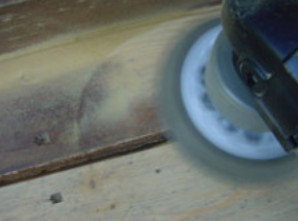 If one of the things you’ve got to show for the passing of summer is a new wooden fence, deck or some lawn furniture, then your chance to get that wood protected under a coat of finish is slipping away faster than the dwindling day length. But don’t despair. You still have time to get your outdoor wood ready for the coming winter and many more seasons of well-protected exposure down the road. What you’ll learn about here is how to make that protection last many years longer than it normally would.
If one of the things you’ve got to show for the passing of summer is a new wooden fence, deck or some lawn furniture, then your chance to get that wood protected under a coat of finish is slipping away faster than the dwindling day length. But don’t despair. You still have time to get your outdoor wood ready for the coming winter and many more seasons of well-protected exposure down the road. What you’ll learn about here is how to make that protection last many years longer than it normally would.
Whether you choose paint, stain or UV-resistant exterior varnish, the most effective thing you can do to greatly increase the useful life of any outdoor wood coating is pre-application sanding. There is another approach that I’ll tell you about here too, but sanding is best and it’s the thing you should try to do if possible.
Pre-application Sanding
The reason sanding provides such an excellent base for durable outdoor finishes is because it greatly increases the sub-surface absorption of finishing products. Here’s why:
- Any smooth lumber you buy will have passed through a machine that used sharp, rotating blades to plane the wood.
- The fast action of these blades invariably creates heat that burnishes the wood’s surface and greatly reduces it’s ability to absorb paints, stains and sealers.
- Sanding removes this burnished surface and opens the wood’s pores so any finish can soak right in. Greater absorption means greater durability.
Sanding large expanses of outdoor wood hasn’t received a wide following in the past because the sanding equipment that existed up until recently wasn’t suitable for the job. A homeowner facing the prospect of sanding, say, a typical wooden deck back in the 1980’s would be forced to choose between the following three excruciating options:
- A walk-behind floor sander (too big and cumbersome)
- A hand-held belt sander (no good in corners)
- An oscillating finishing sander (way too slow)
Today, however, we have access to a new type of sander that is:
- Light
- Fast-acting
- Small enough to maneuver almost all the way into corners
- Mighty enough to tackle the straight-aways with panache
This kind of power tool is called a “random orbit sander” and certain models that you can rent or buy are wonderfully suited for outdoor sanding prep work. All major power tool manufacturers now offer these machines.
Random Orbit Sander
Random orbit sanders get their name from the random, circular pattern of movement that their round sanding pads travel during operation. This random pattern offers two unique advantages over regular belt or oscillating sanders:
- A much more aggressive sanding action than produced by the same size of machine moving its abrasive parallel to the wood grain.
- Very little cross-grain scratching of the wood surface (despite the circular movement of the sanding pad).
This translates into a machine you can zoom around easily, right into corners, over curved edges and along flat surfaces. When you start exploring the range of random orbit sanders available, you’ll find there are two types:
- Small upright sanders meant for light-duty, single-handed use.
- Larger two-handed models with a cylindrical motor extending to the side like an auto body grinder. The larger type is much better for the big surface areas typical of wooden outdoor items. You want all the power you can get.
Random orbit sanders require round abrasive discs to operate, typically 5 or 6-inches in diameter. These discs come in a range of coarse to very fine grades, but for outdoor prep work all you’ll need is what’s called an “80-grit” abrasive. This means that every square inch of the disc is covered by about 80 individual abrasive particles. This is fairly coarse, as abrasives go, but for outdoor work it’s just fine. In fact, the surface left by an 80-grit abrasive is ideal for providing the maximum grip that an outdoor finish can use, yet it’ll still be fairly smooth to the touch.
Since random orbit sanders can remove a lot of wood quickly, they also produce a lot of dust. Some have built-in dust collectors, but most of the larger models do not. A dust mask is mandatory when sanding with one of these, especially if you’re sanding pressure-treated lumber.
High-pressure Washing
- A second-rate alternative to sanding is high-pressure washing using a solution of trisodium phosphate and water, followed by a blast of plain rinse-water afterwards.
- This approach requires the rental of a pressure washing machine, but it is faster than sanding.
- On the downside, pressure washing doesn’t remove burnishing as effectively as sanding, so it doesn’t open wood pores as effectively.
Besides their use in preparing new wood for finishing, random orbit sanders are also excellent for prepping old wood for a new paint job. In fact, if you’ve got an old house you’re fixing up, a random orbit sander is one of the first machines I’d recommend you buy to help you achieve excellent, long-lasting results.


